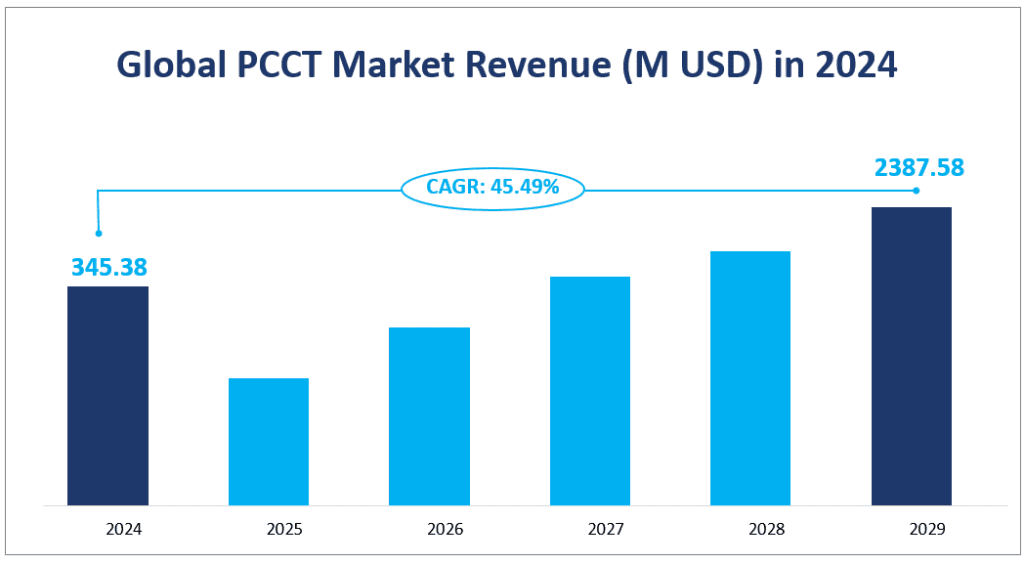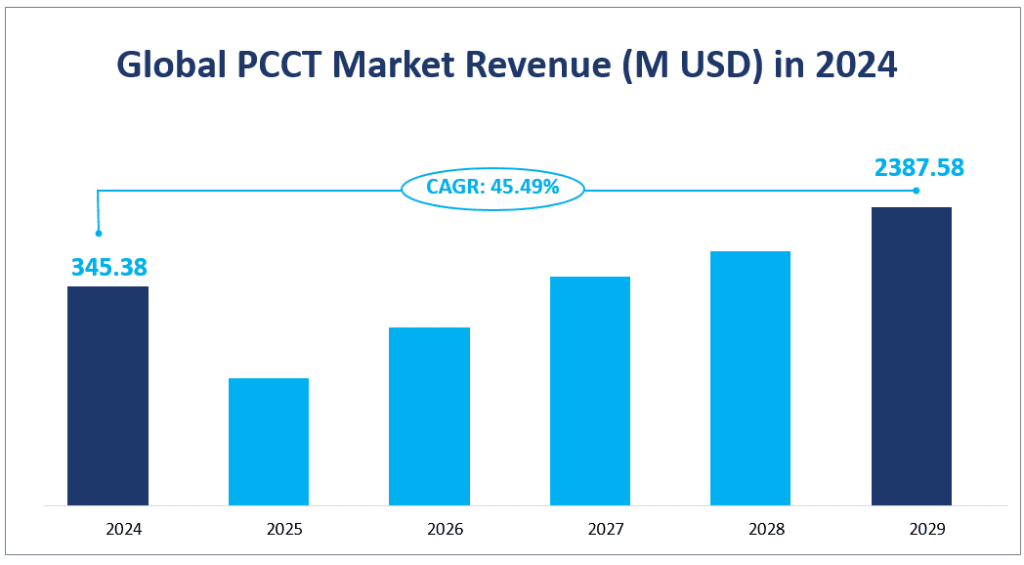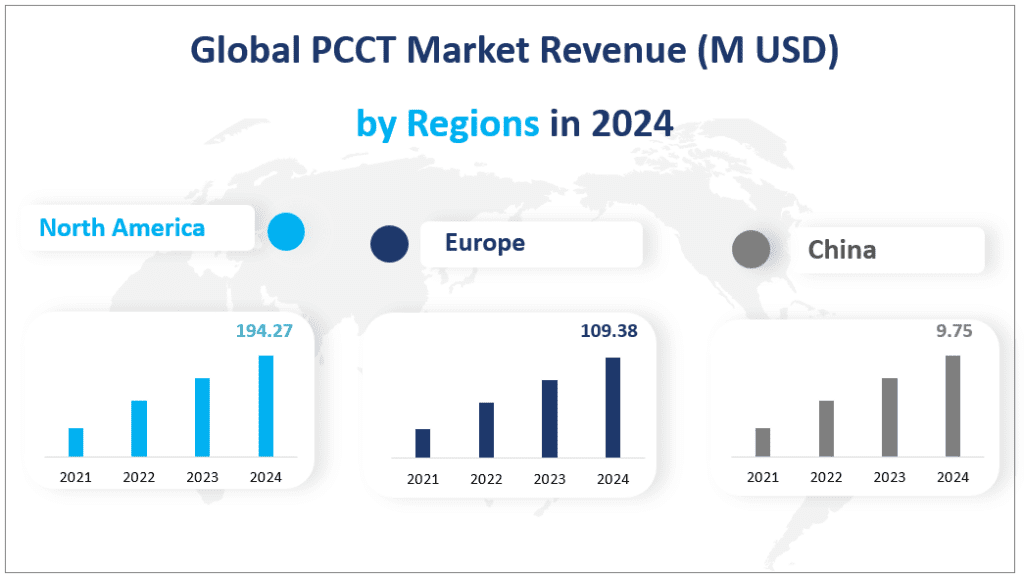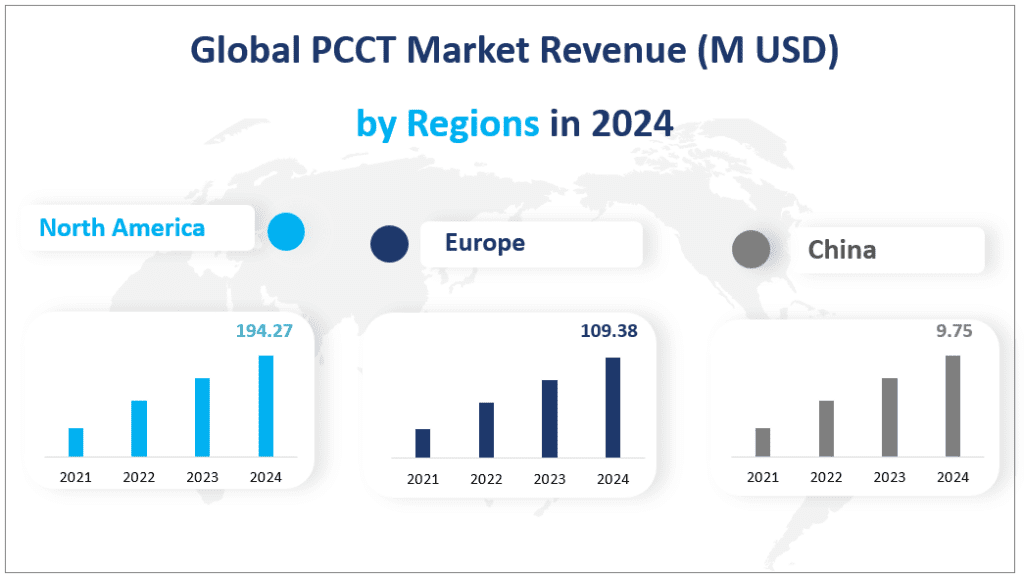1. Global Photon-counting Computed Tomography Market Insights
The global Photon-counting Computed Tomography (PCCT) market size is estimated to reach $345.38 million with a CAGR of 45.49% from 2024 to 2029. This growth can be attributed to the increasing demand for advanced diagnostic tools in the healthcare sector, technological innovations, and the growing prevalence of chronic diseases that require precise imaging for effective treatment.
Photon-counting Computed Tomography, often abbreviated as PCCT, is an innovative technology in the field of computed tomography (CT) scanning. It employs energy-resolving detectors that enable scanning at multiple energy levels. PCCT represents a significant leap forward from traditional CT technology, offering superior image quality with lower radiation doses. The technology has the potential to revolutionize medical diagnostics by providing clearer images of internal structures, improving tissue characterization, and enabling more accurate material density measurements. PCCT’s ability to capture multi-spectral images and reduce radiation exposure makes it a preferred choice for various medical applications, including cardiology, oncology, and neurology.
Global PCCT Market Revenue (M USD) in 2024


2. Driving Factors of the PCCT Market
The growth of the PCCT market is fueled by several key factors. Firstly, the technological advancements in detector materials and data processing capabilities have made PCCT a reality. The shift from traditional energy integration detectors to photon-counting detectors has resulted in improved spatial and density resolution, leading to clearer and more detailed images. Secondly, the increasing global demand for early and accurate diagnosis of diseases, particularly cancer and cardiovascular conditions, has created a significant market for advanced imaging technologies like PCCT. Additionally, the aging global population and the rise in chronic diseases have further driven the need for more sophisticated diagnostic tools.
Another driving factor is the continuous research and development efforts by major players in the medical equipment industry. Companies like Siemens Healthineers, GE Healthcare, Philips, Hitachi, and United Imaging Healthcare are investing heavily in the development of PCCT technology, leading to innovations that expand the clinical capabilities of traditional CT scans. These advancements not only improve patient care but also open up new opportunities for the growth of the PCCT market.
3. Limiting Factors of PCCT Market Growth
Despite the promising prospects, the PCCT market faces certain challenges that could limit its growth. One of the primary constraints is the high cost associated with the development and deployment of PCCT systems. The sophisticated technology and advanced materials required for photon-counting detectors make these systems expensive, which could hinder their widespread adoption, especially in developing regions with limited healthcare budgets.
Another limiting factor is the complexity of the technology itself. The interpretation of multi-spectral images and the large amount of data generated by PCCT systems require specialized knowledge and training, which may not be readily available in all medical facilities. This could pose a challenge in the effective utilization of PCCT technology and potentially slow down its market penetration.
Lastly, the PCCT market is currently dominated by a few key players, which could lead to limited competition and innovation. The high entry barriers, including the need for significant R&D investments and regulatory approvals, make it difficult for new players to enter the market. This concentration of market power could potentially stifle innovation and variety in PCCT solutions.
In conclusion, the global PCCT market is on the cusp of significant growth, driven by technological advancements and increased demand for advanced diagnostic tools. However, the market must navigate the challenges of high costs, technological complexity, and market concentration to achieve its full potential. Despite these limitations, the future of PCCT looks promising, with the potential to transform medical diagnostics and improve patient outcomes worldwide.
4. Global Photon-counting Computed Tomography Market Segment
Photon-counting Computed Tomography (PCCT) has revolutionized the medical imaging industry with its advanced detector technologies. The market is segmented into two primary product types: Cadmium-based Detectors and Silicon-based Detectors. Each type plays a distinct role in the PCCT market, with different implications for image resolution, spectral analysis, and radiation dose reduction.
Cadmium-based Detectors are known for their high sensitivity and energy resolution, making them ideal for capturing detailed images with minimal radiation exposure. In 2024, the market size for Cadmium-based Detectors is projected to be $182.01 million, reflecting their established position in the industry. Despite their effectiveness, Cadmium-based Detectors face challenges in terms of material scarcity and environmental concerns, which could limit their growth rate.
On the other hand, Silicon-based Detectors are gaining traction due to their superior spatial resolution and cost-effectiveness. Silicon is more abundant and has a more established manufacturing process compared to Cadmium, which contributes to its growing market size. In 2024, Silicon-based Detectors are expected to have a substantial market size of $163.37 million. Their growth rate is anticipated to be the fastest among the two types, driven by technological advancements and the increasing demand for high-resolution imaging at a lower cost.
Cadmium-based Detectors, despite their slower growth rate, maintain a significant PCCT market share due to their unparalleled performance in specific clinical applications where high energy resolution is critical.
Applications of PCCT Market Analysis
The PCCT market is also segmented based on its applications, which include Cardiology, Oncology, Neurology, and Others. Each application leverages the unique capabilities of PCCT to enhance diagnostic accuracy and patient care.
Cardiology applications of PCCT are focused on imaging the heart and blood vessels, providing detailed information on cardiac function and vascular health. In 2024, the Cardiology segment is expected to have a significant market size of $127.62 million, highlighting its importance in the non-invasive diagnosis of heart diseases. The growth rate for Cardiology applications is substantial, driven by the increasing prevalence of cardiovascular diseases and the need for precise imaging to guide treatments.
Oncology applications utilize PCCT for tumor detection, staging, and monitoring treatment responses. The Oncology segment is projected to have the largest market size of $159.96 million in 2024, reflecting the critical role of accurate imaging in cancer management. The growth rate for Oncology applications is also high, as advancements in PCCT allow for better visualization of tumors and more effective radiation therapy planning.
Neurology applications of PCCT involve imaging the brain and nervous system, which is crucial for diagnosing neurological disorders and injuries. The Neurology segment is expected to have a growing market size of $32.08 million in 2024. While its growth rate is not as rapid as Oncology, it is steadily increasing due to the need for advanced imaging techniques in the complex field of neurology.
The “Others” category includes applications such as musculoskeletal imaging and general radiology, which also benefit from the high-resolution and low-radiation advantages of PCCT. This segment is anticipated to have a growing market size of $25.72 million in 2024, with a moderate growth rate.
In conclusion, the Oncology application is expected to have the largest market share in 2024, with Cardiology not far behind. Silicon-based Detectors are projected to have the fastest-growing market size among product types, while Oncology applications are leading in terms of market share growth within the PCCT market. These insights underscore the dynamic nature of the PCCT market and the importance of continued innovation to meet the evolving needs of medical imaging across various specialties.
Market Size and Share by Segment
| Market Size (M USD) in 2024 | Market Share in 2024 | ||
| By Type | Cadmium-based Detectors | 182.01 | 52.70% |
| Silicon-based Detectors | 163.37 | 47.30% | |
| By Application | Cardiology | 127.62 | 36.95% |
| Oncology | 159.96 | 46.32% | |
| Neurology | 32.08 | 9.29% | |
| Others | 25.72 | 7.45% |
5. Regional PCCT Market Analysis
The PCCT market is a burgeoning sector within the medical imaging industry, with regions across the globe showing significant growth and adoption of this advanced technology.
North America will emerge as the largest PCCT market, with a substantial market size of $194.27 million in 2024. This region’s dominance can be attributed to the presence of well-established medical technology companies, advanced healthcare infrastructure, and a high demand for cutting-edge diagnostic tools. The North American market is characterized by a mature healthcare system that prioritizes innovation and technological advancement in medical imaging.
Europe follows as a significant player in the PCCT market, with a considerable market size of $109.38 million in 2024 due to its strong medical device industry and a well-developed network of healthcare providers. The region’s investment in research and development has fostered an environment conducive to the growth of PCCT technology.
China is identified as the fastest-growing region in the PCCT market, with a rapidly expanding market size of $9.75 million in 2024. The growth is fueled by the country’s burgeoning healthcare sector, increased investment in medical technology, and a large patient population that demands advanced diagnostic capabilities. China’s strategic initiatives to improve healthcare services and its focus on high-tech medical equipment have contributed to the rapid adoption of PCCT.
Japan also shows a notable PCCT market size, driven by its technologically advanced healthcare system and the aging population’s need for advanced diagnostic tools. The country’s focus on precision medicine and minimally invasive procedures has increased the demand for PCCT systems.
Southeast Asia, India, and Central & South America are regions with growing market sizes, albeit smaller compared to the leaders. These regions are experiencing growth due to improving healthcare standards, increasing awareness about advanced medical imaging, and the rising prevalence of chronic diseases.
In terms of the fastest-growing PCCT market, China takes the lead, with a significant Compound Annual Growth Rate (CAGR). The Chinese market’s growth is driven by the government’s initiatives to modernize its healthcare system and the growing middle class’s demand for high-quality medical services.
Global PCCT Market Revenue (M USD) by Regions in 2024


6. Analysis of Top Five Companies in PCCT Market
Siemens Healthineers is a prominent player in the PCCT market. With a strong heritage in medical technology, Siemens Healthineers offers a range of diagnostic and therapeutic solutions. Their PCCT products are known for their high-resolution imaging and spectral capabilities, which are pivotal in advancing clinical diagnostics.
GE Healthcare is another giant in the medical imaging sector, offering a diverse portfolio of PCCT solutions. GE’s commitment to innovation is evident in its development of advanced detectors and systems that cater to the needs of various clinical applications, from cardiology to oncology.
Philips stands out for its comprehensive approach to healthcare, which includes diagnostic imaging. Philips’ PCCT products are designed to improve patient outcomes through precise imaging and lower radiation doses, making them a popular choice in the market.
Hitachi, with its extensive experience in technology and engineering, has made significant strides in the PCCT market. Hitachi’s offerings include advanced detector technologies that enable more detailed and clearer images, contributing to better diagnostic insights.
United Imaging Healthcare is a relatively newer entrant but has quickly established itself as a key player in the PCCT market. With a focus on innovation and localization, United Imaging Healthcare offers a range of imaging products that cater to the specific needs of different regions, making them a competitive force in the global market.
Major Players
| Company Name | Headquarters | Area Served |
| Siemens Healthineers | Germany | Worldwide |
| GE Healthcare | USA | Worldwide |
| Philips | Netherlands | Worldwide |
| Hitachi | Japan | Worldwide |
| United Imaging Healthcare | China | Worldwide |
1 Report Overview
1.1 Study Scope
1.2 Key Market Segments
1.3 Players Covered: Ranking by Photon-counting Computed Tomography Revenue
1.4 Market Analysis by Type
1.4.1 Global Photon-counting Computed Tomography Market Size by Type: 2021 -2026
1.4.2 Global Photon-counting Computed Tomography Market by Type
1.5 Market by Application
1.5.1 Global Photon-counting Computed Tomography Market Size by Application: 2021-2026
1.5.2 Global Photon-counting Computed Tomography Market by Application
1.6 Study Objectives
2 Global Growth Trends
2.1 Global Photon-counting Computed Tomography Market Perspective (2021-2031)
2.2 Photon-counting Computed Tomography Growth Trends by Region
2.2.1 Photon-counting Computed Tomography Market Size by Regions: 2021 VS 2026 VS 2031
2.2.2 Photon-counting Computed Tomography Market Share by Regions (2021-2026)
2.2.3 Photon-counting Computed Tomography Forecasted Market Size by Regions (2026-2031)
2.3 Industry Trends and Growth Strategy
2.3.1 Market Top Trends
2.3.2 Market Drivers
2.3.3 Market Challenges
2.3.4 Porter’s Five Forces Analysis
2.3.5 Photon-counting Computed Tomography Market Growth Strategy
2.3.6 Primary Interviews with Key Photon-counting Computed Tomography Players (Opinion Leaders)
3 Competition Landscape by Key Players
3.1 Global Photon-counting Computed Tomography Players by Market Size
3.1.1 Global Photon-counting Computed Tomography Revenue by Players (2021-2026)
3.1.2 Global Photon-counting Computed Tomography Revenue Market Share by Players (2021-2026)
3.2 Global Photon-counting Computed Tomography Market Concentration Ratio
3.2.1 Global Top 3 Companies Revenue in 2025 Forecast
3.2.2 Global Top 5 Companies Revenue in 2025 Forecast
3.3 Photon-counting Computed Tomography Key Players Head office
3.4 Photon-counting Computed Tomography Market Company Establishment Date
3.5 Mergers & Acquisitions, Expansion Plans
4 Market Size by Type (2021-2031)
4.1 Global Photon-counting Computed Tomography Market Size by Type (2021-2026)
4.2 Global Photon-counting Computed Tomography Market Size by Type (2026-2031)
5 Market Size by Application (2021-2031)
5.1 Global Photon-counting Computed Tomography Market Size by Application (2021-2026)
5.2 Global Photon-counting Computed Tomography Market Size by Application (2026-2031)
6 North America
6.1 North America Photon-counting Computed Tomography Market Size (2021-2026)
6.2 North America Photon-counting Computed Tomography Market Size by Type
6.3 North America Photon-counting Computed Tomography Market Size by Application
7 Europe
7.1 Europe Photon-counting Computed Tomography Market Size (2021-2026)
7.2 Europe Photon-counting Computed Tomography Market Size by Type
7.3 Europe Photon-counting Computed Tomography Market Size by Application
8 China
8.1 China Photon-counting Computed Tomography Market Size (2021-2026)
8.2 China Photon-counting Computed Tomography Market Size by Type
8.3 China Photon-counting Computed Tomography Market Size by Application
9 Japan
9.1 Japan Photon-counting Computed Tomography Market Size (2021-2026)
9.2 Japan Photon-counting Computed Tomography Market Size by Type
9.3 Japan Photon-counting Computed Tomography Market Size by Application
10 Southeast Asia
10.1 Southeast Asia Photon-counting Computed Tomography Market Size (2021-2026)
10.2 Southeast Asia Photon-counting Computed Tomography Market Size by Type
10.3 Southeast Asia Photon-counting Computed Tomography Market Size by Application
11 India
11.1 India Photon-counting Computed Tomography Market Size (2021-2026)
11.2 India Photon-counting Computed Tomography Market Size by Type
11.3 India Photon-counting Computed Tomography Market Size by Application
12 Central & South America
12.1 Central & South America Photon-counting Computed Tomography Market Size (2021-2026)
12.2 Central & South America Photon-counting Computed Tomography Market Size by Type
12.3 Central & South America Photon-counting Computed Tomography Market Size by Application
13 Key Players Profiles
13.1 Siemens Healthineers
13.1.1 Siemens Healthineers Company Details
13.1.2 Business Overview and Recent Development
13.1.3 Photon-counting Computed Tomography Introduction
13.1.4 Siemens Healthineers Value in Photon-counting Computed Tomography Business (2021-2026)
13.2 GE Healthcare
13.2.1 GE Healthcare Company Details
13.2.2 Business Overview and Recent Development
13.2.3 Photon-counting Computed Tomography Introduction
13.2.4 GE Healthcare Value in Photon-counting Computed Tomography Business (2021-2026)
13.3 Philips
13.3.1 Philips Company Details
13.3.2 Business Overview and Recent Development
13.3.3 Photon-counting Computed Tomography Introduction
13.3.4 Philips Value in Photon-counting Computed Tomography Business (2021-2026)
13.4 Hitachi
13.4.1 Hitachi Company Details
13.4.2 Business Overview and Recent Development
13.4.3 Photon-counting Computed Tomography Introduction
13.4.4 Hitachi Value in Photon-counting Computed Tomography Business (2021-2026)
13.5 United Imaging Healthcare
13.5.1 United Imaging Healthcare Company Details
13.5.2 Business Overview and Recent Development
13.5.3 Photon-counting Computed Tomography Introduction
13.5.4 United Imaging Healthcare Value in Photon-counting Computed Tomography Business (2021-2026)
14 Market Size 2026-2031
14.1 Market Size by Region
14.2 North America
14.3 Europe
14.4 China
14.5 Japan
14.6 Southeast Asia
14.7 India
14.8 Central & South America
15 Analyst’s Viewpoints/Conclusions
16 Appendix
16.1 Methodology
16.2 Research Data Source
16.2.1 Secondary Data
16.2.2 Primary Data
16.2.3 Market Size Estimation
16.2.4 Legal Disclaimer
